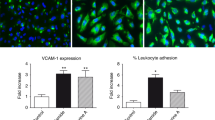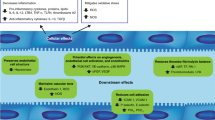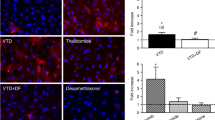Summary:
Fludarabine is a nonmyeloablative immunosuppressant increasingly used as a component of alternative reduced-intensity conditioning regimens prior to allogeneic stem cell transplantation (SCT). However, we have previously shown that 2-fluoroadenine 9-beta- D-arabinofuranoside (F-Ara) as the active metabolized form of fludarabine induces damage, activation and allogenicity in human microvascular endothelial cells (HMEC). We had also identified the pharmaceutic compound Defibrotide (DF), originally used in the treatment of veno-occlusive disease and thrombotic microangiopathy, as being protective against F-Ara-induced dysfunction of HMEC, importantly, without affecting the antileukemic effect of F-Ara. In the present report, we show that a recently developed derivative of DF, Oligotide, similarly downregulates F-Ara-induced activation and damage of HMEC as well as their antigenicity for allogeneic CD8+ T cells. In addition, Oligotide could also block F-Ara-mediated transendothelial migration of peripheral blood cells across the HMEC barrier. Taken together, these observations argue for a potential clinical use of both DF and Oligotide in pre transplant conditioning.
This is a preview of subscription content, access via your institution
Access options
Subscribe to this journal
Receive 12 print issues and online access
$259.00 per year
only $21.58 per issue
Buy this article
- Purchase on Springer Link
- Instant access to full article PDF
Prices may be subject to local taxes which are calculated during checkout



Similar content being viewed by others
References
Carella AM . Treatment of hematological malignancies with allogeneic nonmyeloablative stem cell transplantation: conditioning regimens with fludarabine. Hematol J 2004; 5 (Suppl. 1): S68–S75.
Ferrara JL, Cooke KR, Teshima T . The pathophysiology of acute graft-versus-host disease. Int J Hematol 2003; 78: 181–187.
Bearman SI . Reduced-intensity allogeneic stem cell transplantation. Curr Hematol Rep 2003; 2: 277–286.
Eissner G, Multhoff G, Gerbitz A et al. Fludarabine induces apoptosis, activation, and allogenicity in human endothelial and epithelial cells: protective effect of defibrotide. Blood 2002; 100: 334–340.
Holler E, Kolb HJ, Hiller E et al. Microangiopathy in patients on cyclosporine prophylaxis who developed acute graft-versus-host disease after HLA-identical bone marrow transplantation. Blood 1989; 73: 2018–2024.
Richardson PG, Elias AD, Krishnan A et al. Treatment of severe veno-occlusive disease with defibrotide: compassionate use results in response without significant toxicity in a high-risk population. Blood 1998; 92: 737–744.
Richardson PG, Murakami C, Jin Z et al. Multi-institutional use of defibrotide in 88 patients after stem cell transplantation with severe veno-occlusive disease and multisystem organ failure: response without significant toxicity in a high-risk population and factors predictive of outcome. Blood 2002; 100: 4337–4343.
Skurk C, Nuss C, Lefer AM . Beneficial effects of oligotide, a novel oligodeoxyribonucleotide, in murine traumatic shock. Shock 1995; 3: 13–20.
Murohara T, Ikeda H, Duan J et al. Transplanted cord blood-derived endothelial precursor cells augment postnatal neovascularization. J Clin Invest 2000; 105: 1527–1536.
Rossoni G, Berti F, Berti M et al. Oligotide, a new single-stranded oligodeoxyribonucleotide, preserves postsynaptic beta-adrenergic and cholinergic receptor functions in rabbit hearts after acute infarction. Thromb Res 1995; 78: 429–440.
Marni A, Forti D, Calvillo L et al. Anti-ischemic effect of oligotide treatment in rat kidney: comparison with the effect of nifedipine and isosorbide dinitrate. Transplant Proc 1996; 28: 301–303.
Marni A, Forti D, Cavillo L et al. Protection of rat kidney from ischemia reperfusion injury by oligotide. Transplant Proc 1996; 28: 297–300.
Pellegatta F, Ferrero E, Marni A et al. Oligotide anti-ischemic effect is related to in vitro inhibition of leukocyte-endothelial cell adhesion. Transplant Proc 1996; 28: 339–341.
Scalia R, Gauthier TW, Murohara T, Lefer AM . Oligotide attenuates leukocyte-endothelial cell interaction via P-selectin in the rat mesenteric vascular bed. Eur J Pharmacol 1996; 296: 181–187.
Pellegatta F, Ferrero E, Marni A et al. The anti-ischemic drugs defibrotide and oligotide analogously inhibit leukocyte-endothelial cell adhesion in vitro. Transpl Int 1996; 9 (Suppl. 1): S420–S424.
Ades EW, Candal FJ, Swerlick RA et al. HMEC-1: establishment of an immortalized human microvascular endothelial cell line. J Invest Dermatol 1992; 99: 683–690.
Cotter TG, Lennon SV, Glynn JM, Green DR . Microfilament-disrupting agents prevent the formation of apoptotic bodies in tumor cells undergoing apoptosis. Cancer Res 1992; 52: 997–1005.
Lee A, Whyte MK, Haslett C . Inhibition of apoptosis and prolongation of neutrophil functional longevity by inflammatory mediators. J Leukoc Biol 1993; 54: 283–288.
Bird IN, Spragg JH, Ager A, Matthews N . Studies of lymphocyte transendothelial migration: analysis of migrated cell phenotypes with regard to CD31 (PECAM-1), CD45RA and CD45RO. Immunology 1993; 80: 553–560.
Berman ME, Xie Y, Muller WA . Roles of platelet/endothelial cell adhesion molecule-1 (PECAM-1, CD31) in natural killer cell transendothelial migration and beta 2 integrin activation. J Immunol 1996; 156: 1515–1524.
MacDonald HR, Engers HD, Cerottini JC, Brunner KT . Generation of cytotoxic T lymphocytes in vitro. II. Effect of repeated exposure to alloantigens on the cytotoxic activity of long-term mixed leukocyte cultures. J Exp Med 1974; 140: 718–730.
Eissner G, Lindner H, Behrends U et al. Influence of bacterial endotoxin on radiation-induced activation of human endothelial cells in vitro and in vivo: protective role of IL-10. Transplantation 1996; 62: 819–827.
Lindner H, Holler E, Gerbitz A et al. Influence of bacterial endotoxin on radiation-induced activation of human endothelial cells in vitro and in vivo: interleukin-10 protects against transendothelial migration. Transplantation 1997; 64: 1370–1373.
Sandoval A, Consoli U, Plunkett W . Fludarabine-mediated inhibition of nucleotide excision repair induces apoptosis in quiescent human lymphocytes. Clin Cancer Res 1996; 2: 1731–1741.
Huang P, Siciliano MJ, Plunkett W . Gene deletion, a mechanism of induced mutation by arabinosyl nucleosides. Mutat Res 1989; 210: 291–301.
Genini D, Budihardjo I, Plunkett W et al. Nucleotide requirements for the in vitro activation of the apoptosis protein-activating factor-1-mediated caspase pathway. J Biol Chem 2000; 275: 29–34.
Eissner G, Kohlhuber F, Grell M et al. Critical involvement of transmembrane tumor necrosis factor-alpha in endothelial programmed cell death mediated by ionizing radiation and bacterial endotoxin. Blood 1995; 86: 4184–4193.
Lindner H, Holler E, Ertl B et al. Peripheral blood mononuclear cells induce programmed cell death in human endothelial cells and may prevent repair: role of cytokines. Blood 1997; 89: 1931–1938.
Chopra R, Eaton JD, Grassi A et al. Defibrotide for the treatment of hepatic veno-occlusive disease: results of the European compassionate-use study. Br J Haematol 2000; 111: 1122–1129.
Kaleelrahman M, Eaton JD, Leeming D et al. Role of plasminogen activator inhibitor-1 (PAI-1) levels in the diagnosis of BMT-associated hepatic veno-occlusive disease and monitoring of subsequent therapy with defibrotide (DF). Hematology 2003; 8: 91–95.
Chalandon Y, Roosnek E, Mermillod B et al. Prevention of veno-occlusive disease with defibrotide after allogeneic stem cell transplantation. Biol Blood Marrow Transplant 2004; 10: 347–354.
Acknowledgements
This work is supported by grant No. Ei68/2-3 from the Deutsche Forschungsgemeinschaft (DFG) and the Marie Curie Research Training Network of the 6th Framework Programme of the European Commission.
Author information
Authors and Affiliations
Corresponding author
Rights and permissions
About this article
Cite this article
Eissner, G., Iacobelli, M., Blüml, S. et al. Oligotide, a defibrotide derivative, protects human microvascular endothelial cells against fludarabine-induced activation, damage and allogenicity. Bone Marrow Transplant 35, 915–920 (2005). https://doi.org/10.1038/sj.bmt.1704930
Received:
Accepted:
Published:
Issue Date:
DOI: https://doi.org/10.1038/sj.bmt.1704930
Keywords
This article is cited by
-
The role of the endothelium in the short-term complications of hematopoietic SCT
Bone Marrow Transplantation (2011)
-
Pulmonary veno-occlusive disease following hematopoietic stem cell transplantation: a rare model of endothelial dysfunction
Bone Marrow Transplantation (2008)



